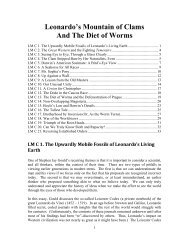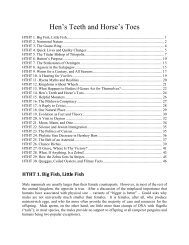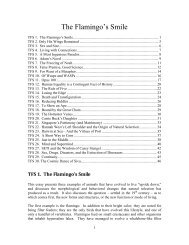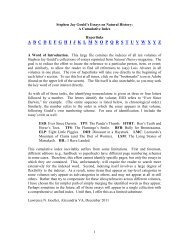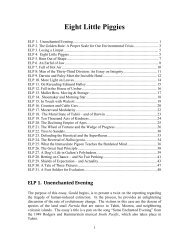other departments, something that rarely happens at Harvard due to intense overcommitment.The comparative rareness of visitors, such as himself, also leads to anexceptionally warm reception from his hosts. One of the ways in which the facultyexpressed their gratitude with his visit was to drive him two hours northeast to a fossillakebed discovered twenty years earlier in the tiny town of Clarkia.Francis Keinbaum discovered the Clarkia lakebed in 1971, while using a bulldozer tocreate a skimobile racetrack on his land. The lake formed about 20 million years ago,during the Miocene period, and lasted about a thousand years. The sediments that filledit in are about 100 feet thick. While these sediments contain occasional insects and manymicrofossils, the most spectacular finds here are the leaves. When the waterlogged rockis split (with a kitchen knife!), leaves that look no different from the day they fell appearat each bedding plane. Most are green, but many possess autumnal colors. Within a fewminutes, the leaves dry to a black film and blow away. The excellent preservation is dueto three factors: the leaves fell directly into the lake rather than being transported by somemechanism; the lack of oxygen in the ancient lake, which prevented their decomposition;and that the ground remained waterlogged and oxygen-free for the entire 20-millionperiod. The preservation is so good that cellular structure and leaf chemistry can beexamined. One of the most exciting aspects of these fossil leaves is that DNA can beextracted from the chloroplasts (although not, so far, the nuclei, which are not as wellpreserved). Before the sequencing of these fossils, the oldest DNA ever extracted wasfrom a 13,000-year-old sloth; this discovery pushed that date back by three orders ofmagnitude. Comparisons of the large DNA fragments with their modern equivalentsprovide direct evidence of an important genetic principle: changes in the genome occurfar more commonly in those parts that do not code for anything, or are redundant [seeELP 28]. This property had been inferred from studies of modern DNA, but this was thefirst case that demonstrated it explicitly.When Keinbaum first saw these leaves in the layers he dug up, he recognized that theywere not like any leaves that lived in Idaho today. He contacted the closest scientificcommunity (at the university in Moscow). It was quickly determined that two of themost common leaves belonged to magnolias and cypress trees. These are warm-climatetrees that exist today only in the southern Appalachians of the US, and in parts of Asia.Scientists had known that the Miocene was much warmer than today, but the evidence ofa detailed warm-weather ecosystem from that era in Idaho was a remarkable find.Gould makes a few more points in closing. DNA sequencing adds important knowledge,he says, but it is an augmentation to old-fashioned fossil collection and museum curation,not a replacement for them. He encourages his paleontological colleagues to not be soself-deprecating about this. He also expands upon the counter to the creationist argumentthat evolution makes no predictions and therefore cannot be tested. First, it does makepredictions, he states; if one found human remains in previously unexplored Miocenedeposits, it would damage at least parts of the theory of evolution. Second, the fact thatgenetics leads to a structure of life that is so close to that worked out by studies ofmacroscopic forms (fossil and extant) is one of the strongest pieces of evidence that lifeevolves.42
DIH 32. The First Unmasking of NatureGould begins by gently spoofing his own ability to produce an analogy under almost anycircumstances. He shows images of the two sides of a 50-Kroner note from Sweden,which shows King Gustav III (reigned 1771 – 1792) on one side and Carl von Linne(“Linnaeus,” 1707 – 1778) on the other. Besides this connection via the mint, both areinvolved in a story of a disguise within a disguise. <strong>In</strong> King Gustav’s case, he was thesubject of an opera by Verdi that involved a masquerade ball. For many years after theopera was written, due to politics, Gustav could not be identified by name – so thelocation of the story was moved to Boston, where the King was transformed into aGovernor. Hence Gustav was masked twice in Verdi’s tale: first by the characterdonning a costume to attend the ball, and secondly by change in the nationality of thecharacter himself. As for Linnaeus, he is credited by Gould as the man who removed oneof the two metaphorical masks that had prevented people from correctly understandingbiology. (Darwin, in this analogy, would later remove the other.)Thomas Henry Huxley wrote that all sciences proceed through three stages. The first ofthese, which he refers to as Natural History, involves raw data collection with notheoretical construct at all. Gould argues here [as he does elsewhere – see DIH 12, inparticular] that this is actually impossible – some sort of model must be in play, or thedata cannot even be gathered. (He also reiterates his argument that science does notmove in a straight line as Huxley suggests here, but rather in fits and false starts.However, this structure serves his immediate purpose, so he continues.) Huxley’s secondstep is Natural Philosophy, which uses various empirical methods to group the data, butstill has no theoretical underpinning. Finally, Huxley’s final stage of sciencedevelopment is Physical Science, which incorporates a theoretical construct to “makesense” of the organized data, in terms of cause and effect. Huxley was clearly writingabout the transformation of biology into a true science in the 19 th century, with hiscompatriot Darwin as the bridge to the third stage. The source of the transition from thefirst to the second stage, according to Huxley, was Linnaeus. Gould concurs.Linnaeus grouped organisms by their common physical characteristics, rather than bytheir function or behavior. For example, as mentioned in DIH 30, he grouped whaleswith mammals instead of fish. He is credited with being the first to use the “species” inall cases as the fundamental unit of biology. He also invented an important taxonomicnomenclature: the use of single words for the identification of genus and species,formalized in the tenth edition of his Systema Naturae in 1758. This seemingly minornaming scheme turns out to be critically important for organizing life hierarchically,much as Arabic (vs. Roman) numerals greatly assist in algebra. However, Linnaeus wasno evolutionist – perhaps not a surprise considering that he worked a century beforeCharles Darwin published Origin of Species. He was a strict creationist, and hisworldview was that he had glimpsed part of God’s thought process in his taxonomicstructure. [Gould discusses how Linnaeus developed a taxonomy that fits evolutionarytheory so well without being an evolutionist in IHL 21, and problems that arise when thisstructure is applied to inappropriate subjects such as rocks and minerals in the same essayand in LMC 4.]43
- Page 4 and 5: cloud (“nebula”) of gas and dus
- Page 6 and 7: goodness, and is both intelligent a
- Page 9: The second news story involves the
- Page 12 and 13: key ways. Prior to 1994, no fossil
- Page 14: DIH 11. Lucy on the Earth in Stasis
- Page 17: directly resulted in a mass extinct
- Page 20 and 21: Edgar Allan Poe, it turns out, wrot
- Page 22 and 23: things male, while the beautiful is
- Page 24 and 25: interest, until the entrepreneur of
- Page 26 and 27: essay is that scientists, for all t
- Page 28 and 29: DIH 23. The Smoking Gun of Eugenics
- Page 30 and 31: half-Jewish meant Jewish, while qua
- Page 32 and 33: Darwin’s theory, like Adam Smith
- Page 34 and 35: What might a better definition of t
- Page 36 and 37: type of soil, amount of rain, and s
- Page 38 and 39: Case Four, in Gould’s words, is
- Page 40 and 41: multiplying his findings by the num
- Page 44 and 45: Linnaeus, Gould states, did not sim
- Page 46: greatly prefers these metaphors, on




